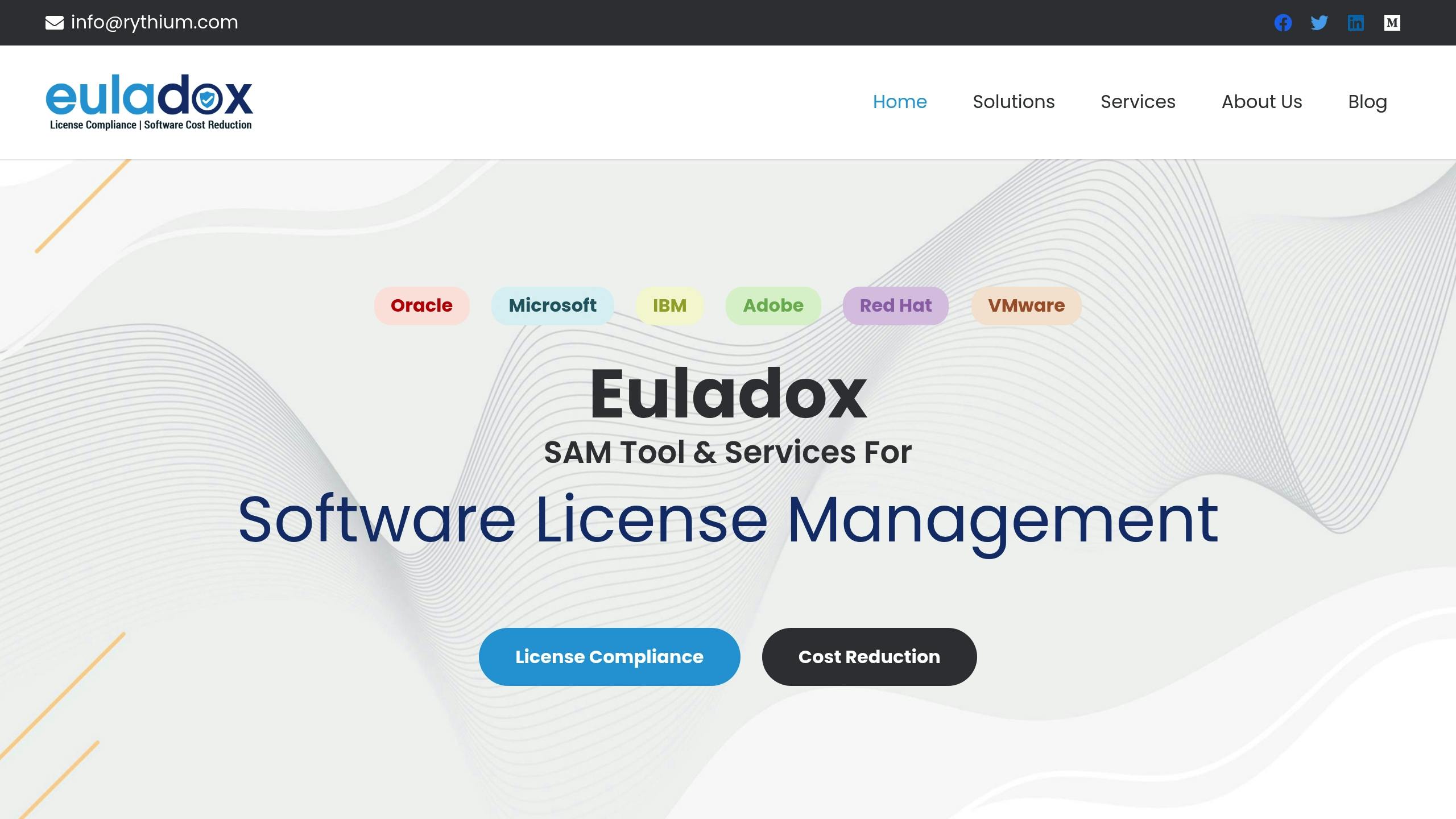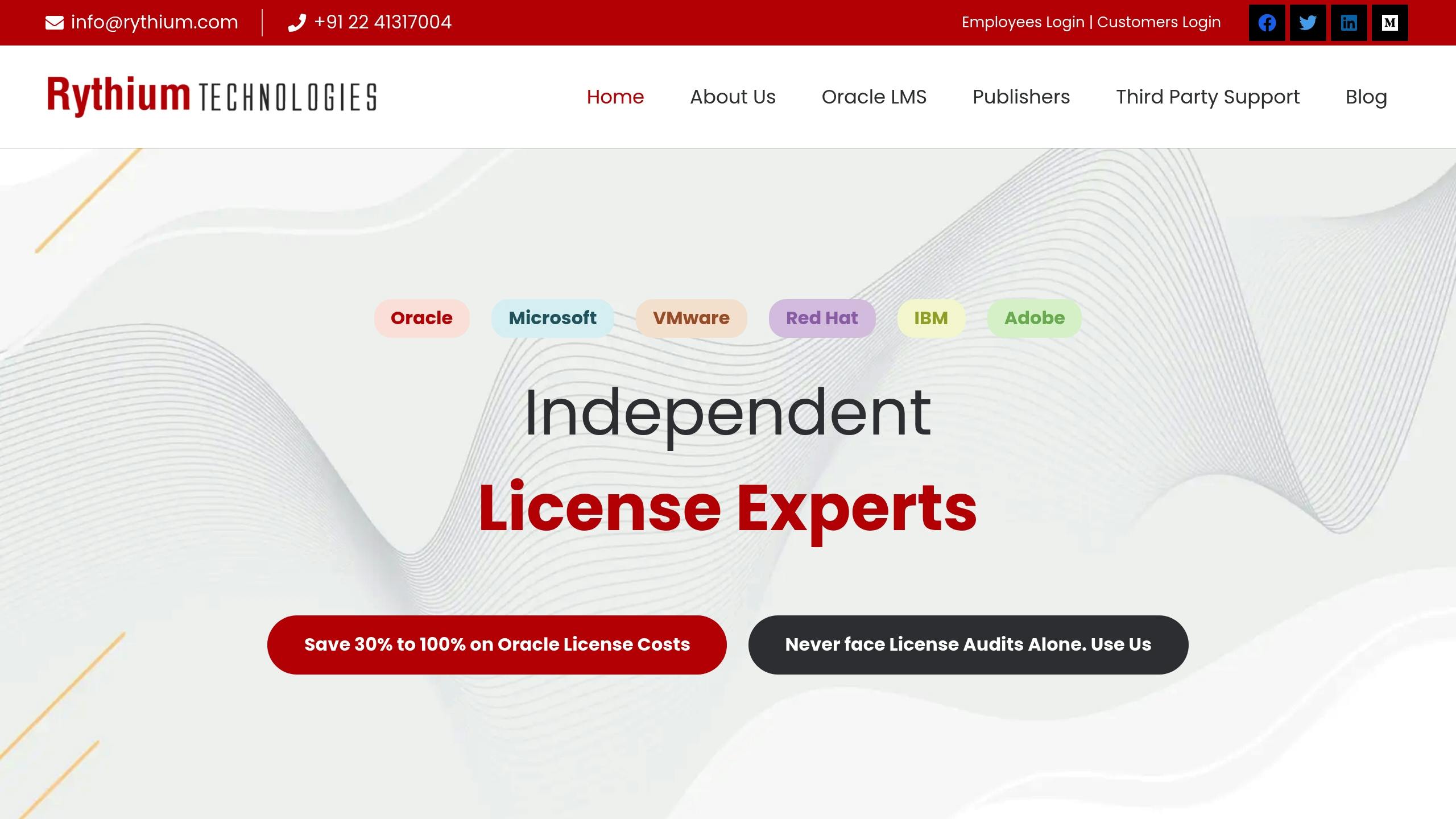5 Ways to Reduce Enterprise Software Licensing Costs
Enterprise software licensing costs can add up quickly, but you can save big by managing them effectively. Here’s how you can cut costs while staying compliant:
- Audit Your Licenses: Identify unused or underutilized licenses and remove them to save up to 30–100%.
- Align Licenses with Usage: Match license purchases to actual needs by analyzing usage patterns and consolidating licenses.
- Negotiate Bulk Discounts: Use volume pricing and long-term agreements to lower per-license costs.
- Implement License Management: Set clear policies, use tracking tools, and conduct regular compliance checks to avoid penalties and waste.
- Explore Alternative License Models: Consider subscription-based, cloud, or open-source options to reduce upfront and maintenance costs.
Webinar: How can you reduce your software licensing costs?
1. Run a Software License Audit
The first step to cutting down on unnecessary licensing costs is conducting a thorough audit. This process helps uncover immediate savings and prevents overspending in the future.
List Current Software and Licenses
Start by creating a detailed inventory that includes:
- Software currently in use across all departments
- Existing license agreements
- Types of licenses (e.g., perpetual, subscription, user-based)
- Renewal dates and associated costs
- Deployment type (on-premise, cloud, or hybrid)
Having a clear record of your software assets is key. Once documented, you can identify and remove unused licenses to turn this information into cost savings.
Find Unused Licenses
Analyzing usage patterns is critical for spotting wasted licenses. Euladox reports that organizations often find savings between 30% and 100% through effective license management [2].
To pinpoint underutilized licenses:
- Monitor software usage over a 3–6 month period
- Track how often users log in
- Take note of seasonal usage patterns
- Look for duplicate licenses
“We have worked with 240+ companies saving them between 30% – 100% of license exposures. Savings range from US$250k to US$60m per customer.” – Euladox [2]
Use Euladox for Audit Support
For the best results, consider expert help. Euladox provides comprehensive software asset management (SAM) services, designed to maximize savings and ensure compliance.
| Audit Component | Service Offering | Benefit |
|---|---|---|
| Baseline Review | Initial license assessment | Clear understanding of assets |
| Usage Analysis | Tracks deployment vs. actual use | Identifies waste and overlaps |
| Compliance Check | Verifies license agreements | Reduces compliance risks |
| Cost Analysis | Evaluates spending patterns | Highlights optimization options |
“From the moment I engaged with the Rythium team, I knew we were in capable hands.” – CIO of an Indian Top Ten Bank [2]
2. Match Licenses to Actual Needs
Once your audit is done, the next step is to align software licenses with actual usage. This helps cut waste and ensures you’re only paying for what you need.
Adjust License Numbers Based on Use
Dive into your usage data to uncover potential savings. Focus on:
- Peak and average usage trends
- Seasonal changes in demand
- Specific needs of different departments
- Levels of access required by users
After making these adjustments, look for opportunities to consolidate licenses across departments for even greater efficiency.
Combine Similar Licenses
Streamline license management by consolidating similar licenses. Here are some ways to do it:
| Strategy | Benefit | Impact |
|---|---|---|
| Enterprise Agreements | Discounts for bulk buying | Cuts costs significantly |
| License Pooling | Shared resources | Increases flexibility |
| Version Standardization | Easier management | Lowers administrative costs |
Get Help from Rythium
For more complex setups, professional help can make a big difference. When your internal efforts hit a wall, expert advice ensures the best results. Rythium offers a hands-on approach that includes:
- Comprehensive usage analysis across all departments
- Identifying areas where licenses can be consolidated
- Vendor negotiation support
- Ongoing recommendations to optimize your software usage
“We had been forced to renew our Oracle ULA once before and didn’t want to repeat the costly mistake without a capable team to help Oracle License Audit Defense. Rythium’s Consultants helped us navigate the compliance, counting and certification process successfully.”
– CIO of an Indian Top Ten Bank [1][2]
Rythium’s team has deep expertise with major vendors like Oracle, Microsoft, IBM, Adobe, Red Hat, and VMware, giving you complete support for your software portfolio.
sbb-itb-4bfa64b
3. Use Bulk Purchase Discounts
Buying in bulk can be a smart way to cut down on licensing costs. After auditing and aligning your licenses, bulk purchasing takes savings to the next level by leveraging economies of scale.
Get Volume Pricing
When you buy in bulk, you can negotiate better deals directly with vendors. Volume licensing not only lowers the cost per license but often includes perks like better support.
Sign Long-term Agreements
Committing to multi-year contracts can help you lock in stable rates and avoid future price hikes. Here’s what to look for:
- Locked-in pricing with flexibility for adjustments
- Priority access to vendor support
- Payment schedules tailored to your budget
- Options to scale license counts as your needs evolve
Securing rates now means you’re better positioned for future negotiations.
“We work closely with these teams to align Oracle licensing expenses with budget constraints, providing financial clarity and helping to avoid unforeseen costs.”
– Rythium Technologies [1]
Work with Euladox Experts
Euladox experts specialize in analyzing your licensing needs, finding bulk purchase opportunities, and negotiating deals that save money while staying compliant. Their experience ensures you get the best terms possible, focusing on volume discounts and well-structured long-term agreements [1][2].
4. Set Up License Management
Managing licenses effectively helps control expenses and ensures your organization stays compliant. After completing audits and aligning your licenses, maintaining good management practices can lead to ongoing savings.
Write Clear License Rules
Establishing clear rules helps avoid expensive mistakes. These should cover:
- Approval processes for purchases
- License distribution
- Monitoring software usage
- Verifying compliance regularly
Use Tracking Software
Once policies are in place, tracking tools can help you monitor software usage in real time. For example, the Euladox Software Asset Management (SAM) platform offers:
| Feature | Benefit |
|---|---|
| Real-time Usage Monitoring | Spot underused licenses quickly |
| Automated Compliance Checks | Lower the risk of falling out of compliance |
| License Optimization Tools | Cut license costs by 30–100% |
| Multi-vendor Support | Handle licenses for Microsoft, Oracle, IBM, Adobe |
Check Compliance Monthly
After the initial audit and policy setup, regular reviews are key to keeping your license management in shape. Monthly tasks should include:
- Reviewing software usage reports
- Conducting quarterly compliance audits
- Adjusting license allocations as needed
- Finding new ways to optimize licensing
For example, a leading Indian bank cut its Java licensing costs by 85% through targeted optimization [1][2].
Euladox offers ongoing license management across multiple vendors like Microsoft, Oracle, IBM, and Adobe. As an independent provider, they focus solely on delivering recommendations tailored to your business needs [2].
5. Try Different License Types
Trying out alternative licensing models can help cut software costs effectively.
Compare Subscription Options
Subscription-based licenses are often more affordable than traditional perpetual licenses. While perpetual licenses demand a large upfront payment and limited upgrade cycles, subscriptions lower initial expenses and offer predictable fees that typically include regular updates. Pay-as-you-go options can also align costs with actual usage. Experts at Euladox can assist in evaluating whether switching to a subscription model suits your organization’s needs [1].
Additionally, cloud-based options can provide even more cost-saving opportunities.
Look at Cloud Software
Cloud-based Software as a Service (SaaS) solutions can be more cost-effective than on-premises licenses. They reduce infrastructure expenses, handle updates and maintenance automatically, allow for flexible scaling, and minimize IT support requirements.
For instance, with Rythium’s guidance, some organizations have moved to cloud-based systems and cut their annual licensing costs by up to 50%, all while boosting operational efficiency [1].
Check Open-Source Options
Open-source software can be a strong alternative to commercial solutions, offering enterprise-grade features without licensing fees. However, it’s crucial to evaluate whether these options meet your business requirements. Factors to consider include available support (community vs. professional services), the frequency of security updates, compatibility with your existing systems, and the overall cost of ownership over time. Partnering with specialists like Euladox can ensure you implement open-source tools that are secure and compliant.
These licensing strategies provide practical ways to lower software expenses.
Conclusion
Managing enterprise software licensing costs calls for a well-thought-out approach that uses a mix of methods. The five strategies discussed – from conducting detailed audits to considering alternative license types – offer a solid framework for cutting costs effectively.
Specialized partners like Euladox and Rythium have demonstrated their ability to deliver impressive savings, reducing license exposures by anywhere from 30% to 100%. These savings can range from $250,000 to $60 million per client, depending on the scale of the operation[1][2]. Their expertise helps businesses navigate the complexities of licensing, ensuring compliance while minimizing costs.
Real-world success stories back up these methods. With support from partners like Rythium and Euladox, organizations have improved vendor relationships, optimized license usage, and implemented better management practices – achieving measurable outcomes[1][2].
To build on these strategies, enterprises should focus on:
- Regularly reviewing licenses and monitoring compliance
- Aligning license purchases with actual needs
- Seeking professional advice during vendor negotiations
- Adopting effective license management systems
By working with experienced partners and applying these tested methods, businesses can cut software licensing costs significantly while staying compliant and efficient. Optimizing licenses isn’t a one-time task – it’s an ongoing process that evolves with changing business demands.






